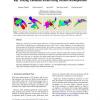Free Online Productivity Tools
i2Speak
i2Symbol
i2OCR
iTex2Img
iWeb2Print
iWeb2Shot
i2Type
iPdf2Split
iPdf2Merge
i2Bopomofo
i2Arabic
i2Style
i2Image
i2PDF
iLatex2Rtf
Sci2ools
CGF
2006
2006
Ray Tracing Animated Scenes using Motion Decomposition
Though ray tracing has recently become interactive, its high precomputation time for building spatial indices usually limits its applications to walkthroughs of static scenes. This is a major limitation, as most applications demand support for dynamically animated models. In this paper, we present a new approach to ray trace a special but important class of dynamic scenes, namely models whose connectivity does not change over time and for which all possible poses are known in advance. We support these kinds of models by introducing two new concepts: motion decomposition, and fuzzy kd-trees. We analyze the animation and break the model down into submeshes with similar motion. For each of these submeshes and for every time step, we calculate a best affine transformation through a least square approach. Any residual motion is then captured in a single "fuzzy kd-tree" for the entire animation. Together, these techniques allow for ray tracing animations without rebuilding the spa...
| Added | 11 Dec 2010 |
| Updated | 11 Dec 2010 |
| Type | Journal |
| Year | 2006 |
| Where | CGF |
| Authors | Johannes Günther, Heiko Friedrich, Ingo Wald, Hans-Peter Seidel, Philipp Slusallek |
Comments (0)

